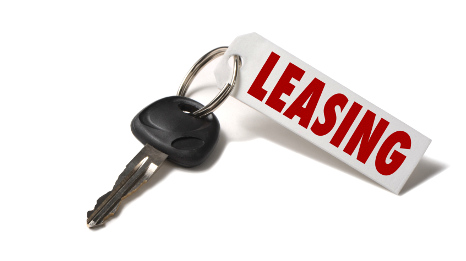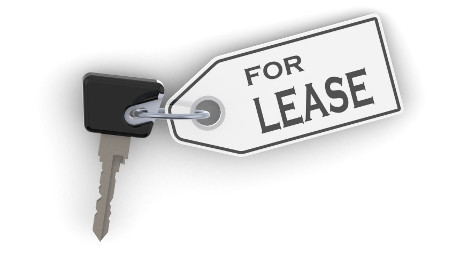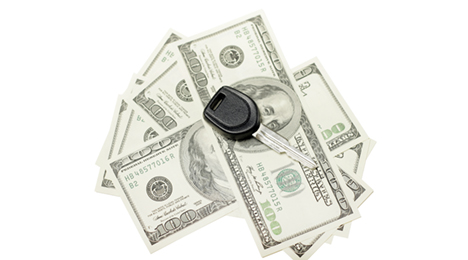The Nissan Sentra SV has come out on top of Wantalease.com’s monthly list of lease deals. The compact sedan is currently being offered for $129 a month.
Two other vehicles in the car segment — the Volkswagen Jetta S at $139 and the Ford Focus at $149 — came in under the $150 mark.
Seven other cars are currently offered for less than $200 a month:
—Toyota Corolla, $159
—Chevy Cruze, $169
—Honda Civic, $179
—Chrysler 200 Limited, $189
—Honda Accord, $189
—Nissan Altima, $189
—Volkswagen Passat, $189
"As the year progresses, we can expect to see more deals on leases as dealers continue to find ways to compete against last year's auto sales totals," said Scot Hall, executive vice president of the online car lease marketplace.
Two luxury model vehicles are currently offered at monthly payments under $500: The Lexus RX 350 FWD at $419 and the Acura MDX FWD at $459.
The Cadillac CTS 2.0T RWD saw the largest discount from the previous month, now offered at $309 per month, a 19.35-percent drop from last month's offer. The Chrysler 200 Limited also saw a noticeable drop, currently offered at $189 per month, a 13.32-percent drop from the previous month.
The Toyota Camry SE I4 saw the largest increase in payment deals from the previous month. The car is currently offered at $292.29, a 19.81-percent increase over the last month.
Wantalease.com is a sister marketplace to Swapalease.com.
A couple of years ago when pundits and naysayers wanted to discuss auto financing, often they gravitated toward how the industry’s recovery stemmed from subprime activity, resulting in a possible bubble similar to what created the Great Recession.
While analysts and experts eventually extinguished that line of thinking by showing performance data, these same industry folks could soon be refuting notions that another auto bubble is inflating — but this time because of leasing.
Earlier this month, Experian’s latest State of the Automotive Finance Market report highlighted leasing volume as a share of all new models financed set another record during the second quarter. Analysts indicated leasing continued its strong growth as the share of new vehicles leased jumped from 26.92 percent in Q2 2015 to a record high of 31.44 percent in Q2 2016.
Then this week, J.D. Power and LMC Automotive indicated that they have never seen franchised dealers slap as much cash on the hood as they are seeing this month to keep new metal turning.
Analysts reported on Monday that incentive spending thus far in September is at a record level of $3,923 per unit. That figure surpassed the previous high of $3,753 set in December 2008.
To gauge whether these trends should be triggering alarms, we visited again with Anil Goyal, senior vice president of automotive valuation and analytics at Black Book, which pushed out online survey results involving more than 500 auto finance company executives. The survey released this week showed a large number of auto finance companies say they don’t leverage residual data for their portfolio despite the majority of finance companies admitting that portfolio risk assessment and remarketing remain at the top of their portfolio strategy for a growing number of used vehicles.
“The environment we are in is more volatile with trends that are very different than what we’ve seen in the last five years, with more supply coming back, with more incentives on the new vehicle sales and leases, with increased use of leasing,” Goyal said.
“There is increased risk around residuals in both loan and lease portfolios in trying to understand what that vehicle might be worth when it’s returned or repossessed,” he continued.
Goyal recapped that projecting residual values certainly is challenging for automakers and their captives since there are “a lot of moving parts.” The OEM must coordinate production schedule, work with suppliers and forecast how much demand for a particular model there might be.
And if their projections are off, Goyal pointed out automakers can join forces with captives to incentivize their customers to take delivery. They can simply reduce the vehicle price; that's the cash on the hood. They can reduce the APR, especially since captives originate leases mostly with prime and super-prime customers.
Also, they can offer a subvented residual enhancement. For example, if the residual value projection for a vehicle is 55 percent of its worth as a new model after three years, the OEM and captive can bump up the level to 60 percent in order to make the customer’s lease payment more manageable.
“There’s a lot of those levers that the OEM and the captives have to play around with to ensure that they are making the sales on their existing vehicles and keeping their pricing competitive with others and monitoring that scenario to make the lease payment work,” Goyal said.
But off-lease vehicles are increasing in the wholesale space. Certified pre-owned sales continue to set records, but what if retail demand for those units diminishes?
“Definitely the risks in the leasing scenario are increasing. Essentially, the captive and manufacturers sometimes when they share the risk, you’re essentially pushing the losses to the back end. You’re making the sale, but you’re going to have a loss,” said Goyal, who is one of the experts coming to Used Car Week at the Red Rock Resort and Casino in Las Vegas Nov. 14-18.
“In the last few years, used-car values have been very strong, so in many cases the vehicle that got returned there was not a loss,” he continued. “In fact, in many cases there was a profit to be made because the values were higher than the residuals, especially on SUVs and trucks. But that has really propelled lease penetration.
“The forecast is lower now for where the values are going to be,” Goyal went on to say. “If more and more leases are essentially made feasible to keep that payment lower through subvented residuals, you’re now going to have a situation where the losses will start to appear on the returns.”
So does leasing bubble talk have merit? Goyal didn’t go to that degree during our conversation on Wednesday. He reiterated how leasing is primarily in the prime and super-prime credit tiers. He added rating agencies often make conservative forecasts when making their analysis of securitizations filled with leases.
“We don’t see it as a bubble, but I do think there is an increased risk developing,” Goyal told Auto Remarketing. “That essentially limits how long leasing can grow.
“If we have higher and higher incentives to make the leasing work, you’re essentially moving from selling that vehicle to really just providing the vehicle on a three-year lease and pushing out your losses as a captive and manufacturer,” he continued. “That’s a trend that could be disturbing if it continues to grow by increasing the risk in the system.”
To help mitigate that risk, Black Book’s latest white paper, “How To Grow a Profitable Used Leasing Portfolio,” can help finance companies identify which vehicles make good used leasing candidates for their portfolio. It is available for download by clicking here.
“You don’t want to have unexpected surprises,” Goyal said. “What we promote to our lenders is not a one-and-done kind of analysis. Rather it’s something that’s ongoing, a refresh of the forecast because the trends are changing.”
Despite record numbers of new vehicles rolling over the curb as leased models, Black Book Lender Solutions discovered a large number of auto finance companies say they don’t leverage residual data for their portfolio. The findings arrived despite the majority of finance companies admitting that portfolio risk assessment and remarketing remains at the top of their portfolio strategy for a growing number of used vehicles.
The new data is from a recent Black Book online survey that asked more than 500 auto finance company executives questions about their portfolio strategies.
Black Book found through its survey that 64 percent of finance companies do not leverage residual data when evaluating their portfolio, yet most (39 percent) said remarketing, which relies heavily on collateral insight, is their largest strategy for dealing with the increased volume of lease returns.
The online survey, which took place during early September, also ironically revealed that 74 percent of finance companies believe residual data is either critical or valuable in key areas to their business.
Given forecasts of increased supply and accelerating vehicle depreciation, a majority of finance companies (52 percent) said they’ll be focused on tightening underwriting criteria as a way to better manage their portfolio risk in the future.
“Residual forecast and collateral data can play an instrumental role in managing risk and increasing profit potential for any lender portfolio,” said Anil Goyal, senior vice president of automotive valuation and analytics at Black Book, who also will be one of the experts at Used Car Week at the Red Rock Resort and Casino in Las Vegas Nov. 14-18.
“Not all vehicles depreciate alike, and residuals can help determine how certain vehicles will perform in a portfolio, particularly as lenders become more curious as to new strategies for off-lease supply,” Goyal continued.
How are auto finance companies utilizing residuals for their portfolios? (Some executives chose more than one):
• Portfolio risk assessment (49 percent)
• Remarketing strategies (42 percent)
• Mark-to-market analysis (39 percent)
• Used-loan originations (39 percent)
• New-loan originations (35 percent)
• Lease-return strategy (26 percent)
• New-lease originations (26 percent)
• Used-lease originations (19 percent)
Finance companies remain curious about the prospects of used leasing.
The survey revealed that 52 percent of finance companies believe used leasing is something worth exploring given current market conditions.
Black Book’s latest white paper, “How To Grow a Profitable Used Leasing Portfolio,” can help finance companies identify which vehicles make good used leasing candidates for their portfolio. It is available for download by clicking here.
The dog days of summer turned out to be the most difficult stretch of the year so far for lease approvals.
Swapalease.com reported vehicle lease credit applicants registered a 57.7 percent approval rate for August — the lowest rate the market has seen in 2016 and also the lowest rate for the month of August in the past two years.
For comparison, site officials pointed out that a year ago the approval rate reached 85.7 percent during the same month.
The monthly lease credit approval rates have been declining steadily since February. While August's approval rate is only 1.1 percent lower than July's rate, it is also only 3.2 percent higher than the lowest approval rate in 2015 and 1.2 percent higher than the lowest approval rate in 2014.
Rather than this trend serving as an indicator of a softening credit market, Swapalease.com executives believe a rising number of overall applications from increased lease interest are pushing the overall rate downward.
"Car lease credit approvals typically fluctuate throughout the year, so to see a downward trend spanning more than six months is unusual,” Swapalease.com executive vice president Scot Hall said.
“However, with lease interest at all-time highs, it is expected that the number of declines will also be added to the mix here,” Hall continued.
In what should portend strong certified pre-owned unit sales down the road, Experian’s latest State of the Automotive Finance Market report highlighted leasing volume as a share of all new models financed set another record during the second quarter.
Analysts on Tuesday indicated leasing continued its strong growth as the share of new vehicles leased jumped from 26.92 percent in Q2 2015 to a record-high of 31.44 percent in Q2 2016.
Even used vehicle leasing, which accounts for a small slice of the lease market, experienced growth, moving from 3.26 percent share in Q2 2015 to 3.71 percent in Q2 2016.
The credit quality of those new leases that were originated during the second quarter remained strong as 48.10 percent of those lessees fell into the prime tier with credit scores at 661 to 780. Finance companies decided to take a little more risk in the lease space, too: Experian noticed a 17 basis point rise in leases to subprime customers as the Q2 level came in at 7.41 percent.
5 times more super-prime paper than deep subprime originated in Q2
With used-vehicle financing leading the charge, Experian’s report showed finance companies booked significantly more contracts with super-prime customers during the second quarter than they did with deep subprime consumers.
Creating what analysts called steady growth and remarkable stability quarter-over-quarter, the second-quarter report determined that auto finance companies made more than five times as many loans to super-prime customers (17.9 percent of total auto loans and leases) as to deep-subprime customers (3.5 percent of total auto loans and leases).
That influx of higher-grade paper meant the combined subprime and deep-subprime share of new- and used-vehicle loans and leases dropped from 23.3 percent in Q2 2015 to 22.8 percent in Q2 2016, according to Melinda Zabritski, senior director of automotive finance for Experian.
“Automotive lenders seem to be keeping cool heads when it comes to how much risk they are willing to take with subprime and deep-subprime customers,” said Zabritski, who is coming back to the SubPrime Forum at Used Car Week for the fourth consecutive year to share more data and trends.
“Yes, subprime and deep-subprime loans are growing, but the entire market is growing from a volume perspective across all risk tiers,” she continued. “In fact, the subprime loans have actually dropped as a percentage of the total market. That, combined with only a slight uptick in delinquencies, makes clear that the sky is not falling.”
Experian determined 30-day delinquencies inched up just 3 basis points year-over-year from 2.19 percent in Q2 2015 to 2.22 percent in Q2 2016. Meanwhile, Experian found that 60-day delinquencies moved just 6 basis points higher from 0.56 percent to 0.62 percent in the same time period.
“Fear of an impending automotive subprime bubble has been swirling around the industry since the recovery from the Great Recession,” Experian said. “Those fears haven’t come to fruition.”
Overall, Experian reported that finance companies held $1.027 trillion in outstanding balances through the second quarter; that’s up from $932 billion a year earlier.
Each of the four major categories of providers that Experian designates posted year-over-year gains in outstanding balances. Those four categories include commercial banks (up by $27 billion), captives (up $13 billion), credit unions ($33 billion) and finance companies that do not hold deposits and often take on subprime risk (up $21 billion).
More used paper in portfolios
Experian highlighted used-vehicle loans grew to record heights in terms of average dollar amount and overall loan share during the second quarter.
The average used vehicle loan reached an all-time high of $19,101 in Q2, up from $18,671 in Q2 of last year.
Used-vehicle contract volume also reached a new peak, accounting for 55.61 percent of all vehicle loans during the second quarter.
Analysts noticed the growth was driven by jumps in prime and super-prime consumers choosing used vehicles. Specifically, 43.3 percent of super-prime consumers selected a used vehicle, which represents a 10 percent increase over 2015. For prime consumers, 59.9 percent chose used, a 6.6 percent increase over the previous year.
This shift also helped push the average credit score for a used vehicle loan from 645 in Q2 2015 to 648 in Q2 2016.
“One of the biggest trends we continue to see is the shift to used vehicles by customers with excellent credit,” said Zabritski, who will appear during the SubPrime Forum, which runs Nov. 14-16 at the Red Rock Resort and Casino in Las Vegas.
“As vehicle prices continue to rise, savvy consumers are looking for ways to control costs. That appears to be pushing more customers toward used vehicles,” she went on to say.
Other Q2 2016 findings:
• The average monthly payment for a used vehicle was $364, up from $361 in Q2 2015.
• The average monthly payment for a new vehicle loan was $499, up from $483 in Q2 2015.
• The average new vehicle loan amount was $29,880, up $1,356 from the Q2 2015 average new vehicle loan amount of $28,524.
• Average customer credit scores for new vehicle loans fell slightly, from 709 in Q2 2015 to 708.
• The average loan term for a new vehicle went from 67 months in Q2 2015 to 68 months.
With leasing activity continuing to intensify, a quartet of experts from Moody’s Analytics devised elaborate formulas and explanations for how to structure residual values that might help captive finance companies, other institutions that provide vehicle leasing as well as other service providers involved with remarketing.
The Moody’s team introduce a new model for forecasting the residual values of vehicles at the 11-digit VIN level under a variety of macroeconomic scenarios.
“We illustrate the plausibility of model forecasts under varying degrees of vehicle usage over multiple time horizons as well as with respect to different macroeconomic scenarios and car features,” the group said in a white paper titled, “Introducing AutoCycle: Residual Risk Management and Lease Pricing at the VIN Level.”
The analysts explained that they discussed and illustrated two additional features, including:
— The ability to calculate exact vehicle values at a given quantile of inferred vehicle quality (for example, the value of a 2013 Honda Accord at the 80th percentile of quality sold in March 2016, conditional on macroeconomic drivers and the car’s observed features)
— The ability to generate forecasts of residual values for vehicle in model years that have not yet come on the market (for example, the residual value of a 2019 Honda Accord sold in July 2022)
“Our model can be used for residual risk management in large lease and auto portfolios as well as for pricing leases on individual vehicles themselves,” said the Moody’s team, which included:
— Tony Hughes, managing director of research
— Samuel Malone, a director in the specialized modeling group
— Michael Brisson, an economist at Moody’s Analytics
— Michael Vogan, an economist in the credit analytics department at Moody’s Analytics
The complete white paper can be downloaded here.
In the second quarter, the average monthly payment on a lease was $431, up from $419 a year ago, according to Edmunds.com.
That also marked the highest Q2 average since 2011, when payments averaged $434 a month.
“Leasing has been a major force in elevating new-car sales for the past three years,” Edmunds said in its Q2 Used Vehicle Market Report. “But as we begin to see a higher number of lease returns enter the used-car market, residual values are beginning to dip, which will likely mean higher prices for lessees.”
For the time being, it does appear there are still some “aggressive” deals to be found, according to an analysis from Wantalease.com, an online new-car lease marketplace.
The sister site to Swapalease.com said that several car models are currently being offered with leases under $150 per month, including the $109/month Nissan Sentra SV.
The others include the Volkswagen Jetta S ($129), Toyota Corolla LE ($139), Ford Fusion SE FWD ($139) and the Volkswagen Passat 1.8T Limited Edition ($149).
On the truck side of the market, Wantalease spotted four models under $200/month: Nissan Rogue S FWD ($179), Toyota RAV4 LE FWD ($179) Chevrolet Equinox 2WD LT ($189) and Honda CR-V LX 2WD ($199).
The analysis also uncovered two luxury models with sub-$300 monthly payments: Audi A3 1.8T Premium ($279) and the Infiniti Q50 3.7 Premium ($299).
"We expect lease deals to continue with an aggressive push as we get deeper into the year since manufacturers and dealers will try to find every opportunity to improve sales figures from the previous year, which broke many records," Scot Hall, executive vice president at Wantalease, said in the analysis.
The site also pointed out that the largest month-over-month discount was found on the Chrysler 300 RWD, whose payment offer fell 24.3 percent to $280. Conversely, the biggest increase was for the Ram 1500 Express Crew Cab 4X4 5'7'', whose payments were up 54 percent at $453.
When consumers take on retail financing for their vehicle purchase, often they’re stretching out terms as long as possible to keep their payments affordable. Experian Automotive put the average new-vehicle contract length at 68 months, according to its first-quarter data.
But when it comes to leasing, just the opposite term is sought by consumers.
The latest Swapalease.com survey showed shoppers are more interested in shorter-term lease options, compared with the traditional 36-month lease. An online survey presented to more than 2,500 drivers across the country showed that roughly 70 percent of participants would like lease terms of 24 months or less as an option at their dealership.
Site officials explained the survey was conducted during the month of July and was inspired in part by Uber’s recent decision to lease vehicles to drivers in 30-day increments. As many as 74 percent of those polled said a 30-day lease is something they are either “maybe” or “absolutely” interested in.
Only 9 percent of survey participants said they would not be interested in hearing about a short-term lease option from their dealer.
As far as types of vehicles go, men and women differ on the type of vehicle they would want to lease for 12-month terms. The survey revealed that women would be more interested in leasing a compact car, hybrid or crossover during that time span, compared with men who indicated their interests to be in premium luxury or sports cars.
In terms of specific brands, women prefer Nissan, Honda and Toyota for a short-term lease, while men indicated a strong preference for Cadillac in a 30-day lease period.
“Short-term lease options are becoming more popular, and will eventually be part of what's offered at a dealership simply because of where consumer preferences now exist,” said Scot Hall, executive vice president of Swapalease.com.
“From short-term mobile phone plans to pay-as-you-consume Netflix programming, consumers are now conditioned to tie larger investments in with their consumption habits, which may dictate the future of automobile shopping patterns and offers,” Hall continued.
So what would it take for a captive finance company or another auto finance provider to gravitate toward leases as short as 30 days? We put that question to Jason Laky, senior vice president and automotive and consumer lending business leader for TransUnion.
“It’s an innovation that Uber is helping to drive into the marketplace. Innovation is always disruptive, and good things can come of it,” Laky said on Tuesday.
“I would say that lenders who are interested in getting into it would do what I think prudent lenders always do when they look at new products is looking at some historical information on the way consumers perform,” he continued.
“Even when there are not comparable leases, there are comparable loan or lease performances on consumers who may be doing similar things,” Laky went on to say. “Use data to try to project how those leases might perform and then test your way into it.
“It’s the way in which our industry has slowly grown the length of terms from 36 months, to 48 to 60 to 72 months over time. It’s been by using data and testing our way into it. I think the same things will apply on shorter-term leases as well,” he added.
While Fitch Ratings said U.S. auto lease ABS residual performance is still producing gains overall through mid-summer despite rising used-vehicle supplies, this week’s update from Swapalease.com about lease approvals wasn’t so positive.
In fact, Swapalease.com reported that the 58.3 percent approval rate for vehicle lease credit applicants in July represented the lowest single-month tally so far in 2016.
And for perspective, site officials mentioned that a year ago the approval rate reached 84.6 percent.
Swapalease.com also pointed out the monthly lease credit approval rate has reached 70 percent just once this year, and that reading arrived in February. Meanwhile, the monthly rate has dropped almost every month since then.
In fact, over the last three months, the approval rate has been just 67.9 percent, according to Swapalease.com, which also noted a recent article in The Wall Street Journal.
According to the newspaper, consumer credit increased recently by the slowest rate in four years as “nonrevolving credit, including student and auto loans, advanced at a 2.07 percent annual pace in June. That was the weakest increase since balances in the category declined in August 2011. May’s growth rate was 7.3 percent, a high for the year.”
Swapalease.com executive vice president Scot Hall considered both what the WSJ reported as well as the metric his firm is seeing when sharing an assessment.
“Lease rates at the dealership remain at all-time highs, and while overall sales of cars and trucks also remain high, the industry looks to be in a peak period,” Hall said in a news release Swapalease.com posted.
“It will be prudent for the industry to pay close attention to other outside indicators, including credit health and credit availability, as we move deeper into the year,” he continued.
During a conversation earlier with Auto Remarketing, we asked Hall about what finance companies and capital providers might do when they watch trends closely. Hall replied to the scenario if institutions decided to pull back and the potential ramifications not only on leasing but traditional retail installment financing too.
“It would end up being a similar situation that we ended up seeing six, seven years ago. You certainly don’t want to see that again anytime soon,” Hall said.
“Leasing is probably going to be what would be cut back first as opposed to financing,” he continued. “That’s what ended up materializing when we went through this years ago.
"Part of the reason, there is generally a similar amount of money allocated to rebates, subvented leasing or whatever the particular make and model may be, but the one thing you would take off the table by putting more focus on the financing potential is that you wouldn’t have the lease remarketing to be concerning yourself with by the manufacturer, captive finance company or any leasing company when that lease comes back in three years down the road or so," Hall went on to say.
“I would argue that it would be a significant factor for both, but leasing would be slightly ahead of the traditional financing in terms of what would be cut back and what would be taken a hard look at first,” he added.
Fitch Ratings took another look at the impact rising wholesale supply is having.
This week, analysts explained U.S. auto lease ABS residual performance is still producing gains overall through mid-summer despite rising used-vehicle supplies. However, Fitch indicated further increases in vehicle supply during the second half of this year and into 2017 could lead to pressure on residual values.
Fitch’s quarterly residual value ABS index slowly declined during the past year. The index recorded a residual value gain of 2.51 percent as of the second quarter of this year, down from 4.79 percent in Q2 2015 and 8.39 percent at Q2 2014.
Analysts noted the average yearly gain in 2014 was 5.75 percent, which then slowed to 3.97 percent in 2015 and averaged 2.10 percent for the first half of this year. They also highlighted the peak residual value gain was 29.21 percent observed in Q1 2011.
Fitch’s outlook for auto lease ABS asset performance remains stable for the second half of this year, supported by continual growing credit enhancement levels resulting in healthy levels of loss protection.
Analysts explained the persistent residual value gains, “albeit at a lower level,” are partially due to the conservative establishment of securitized residuals in U.S. auto lease transactions.
Securitized residuals in U.S. auto lease ABS are often defined as the lesser of residual values established by the servicer at lease inception, Automotive Lease Guide’s (ALG) value at inception, or ALG’s mark-to-market value at the time of the transaction's closing.
By securitizing the lowest of these and comparing that value to lease-end sales prices in determining a residual value loss or gain, there is built-in residual value loss protection, according to Fitch
The firm went on to mention that it expects the pace of upgrades to subordinate notes to continue for auto lease ABS in the second half of this year.
Upgrades are driven in large part to delevering transaction structures and growing credit enhancement levels. Further, Fitch’s base case or “BBsf” residual value loss proxy is conservatively determined by isolating only the residual value losses an issuer observed during the worst 12-18 month period, typically during the weakest 2008-2009 period.
Analysts went on to say additional “haircuts” are employed as rating categories increase. This usually amounts to roughly 28 percent to 32 percent in loss protection as a percentage of returned residuals for “AAAsf” ratings, providing “ample” support, according to analysts.
“Even if residual values continue to decline throughout the remainder of 2016 and into early 2017, loss levels would have to be magnified above those levels to have an impact on outstanding transactions,” Fitch said.
“Used-vehicle volumes entering the secondary market increased significantly due to strong lease originations in recent years,” the firm continued. “This led to higher supply of off-lease vehicles and trade-in volumes.
“Higher fleet and rental volumes entering the secondary market have also pressured residual performance,” Fitch went on to say.
Fitch’s auto lease residual value ABS index also tracks the amount of lease maturities and return volumes.
The index recorded nearly $6.9 billion in returns (securitized residual value amount) in 2015, up from $5.8 billion in 2014. In the first half of 2016, the index posted $3.7 billion in return vehicles, with $4.7 billion more expected in the second half, totaling more than $8.4 billion. This figure represents a 22-percent jump in returns this year versus 2015.
“The used vehicle market saw a shift in consumer preferences in recent years,” analysts said. “With sustained low gas prices and increased fuel efficiency, used vehicle prices for trucks, SUVs/CUVs and vans continue to outperform smaller cars. The full-line category is also outperforming luxury.”
Luxury issuers account for approximately a third of residual returns in Fitch’s Index and have averaged 0.45 percent in residual losses in the first half of this year compared with 2.95 percent in residual gains for full line.
Fitch's auto lease residual value index tracks the performance of 39 U.S. outstanding auto lease transactions totaling $28.4 billion of collateral as of June, issued from 12 auto lease ABS platforms with data dating back to January 2007.












